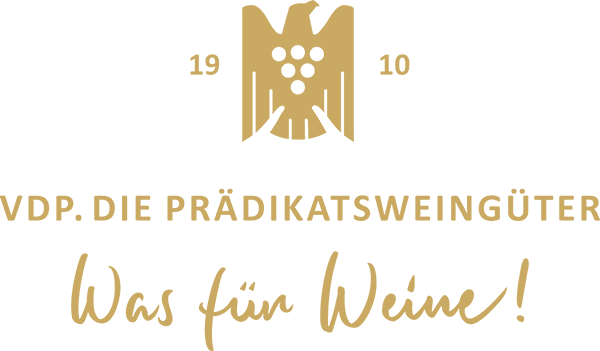The winery Kruger-Rumpf

A Love of Experimentation
In the early 1980s, Stefan Rumpf was the first vintner to plant Chardonnay grapes along the Nahe River. He believed the climate and soil of the Lower Nahe offered the best conditions for this varietal – and he was proven right.
At Weingut Kruger-Rumpf, we are always experimenting. But it’s not all new. Sometimes we go back to traditional methods that were used more than a hundred years ago and modify them.
For instance, we wanted to revive the use of wooden barrels. We did extensive tests with different varietals, wood, toasting level, capacity, and manufacturers until we got the results we wanted.
We also rack off wines from one barrel to another, and bottle our Pinot Noir without filtering it.
Much of what shapes Weingut Kruger-Rumpf today grew out of an experiment – like the Blanc de Noir, which we have offered since the early 1990s.The Common Thread
Experimentation is just as important at Weingut Kruger-Rumpf as preservation is. We are open to both new and old things as long as they suit us.
The important thing for us is that the common thread must be clearly visible throughout Weingut Kruger-Rumpf and all of our wines.
One thing led to another
Almost 40 years ago, our father earned an agriculture degree, which included animal husbandry and breeding. He dreamed of keeping sheep and goats when he retired.
In 2013, we replanted the vineyard terraces at the steepest site, the Münsterer Rheinberg.
We wanted to keep the vegetation as pesticide-free as possible and to avoid stressing the soil with heavy machinery.
Counting Sheep
We believe livestock are an important part of the integrated circular economy in an agricultural operation.
Accordingly, we put five Boer goats out to graze in our vineyards. After they repeatedly escaped, we switched to sheep.
We now have between 15 and 25 sheep and lambs grazing in our vineyards, depending on the season. They serve us well, especially on the steep terraced vineyards of Langenberg and Rheinberg.
Georg and Julia

- 1708
- Ar. 1830
- Ar. 1870
- 1870-1910
- 1910-1945
- 1983
- 1984
- 1988
- 1990
- 1992
- 1993-1994
- 1999
- 2000
- 2008
- 2018
- 2021
- Today
-
 Franz Karl Kruger establishes the Weingut Kruger winery on the Nahe River in Guldental. Over time, the Kruger family buys additional pieces of land along the Lower Nahe.
Franz Karl Kruger establishes the Weingut Kruger winery on the Nahe River in Guldental. Over time, the Kruger family buys additional pieces of land along the Lower Nahe. -
 The Kruger family purchases the elegant maor house in Münster-Sarmsheim and relocates their family home from Guldental to the mouth of the Nahe.
The Kruger family purchases the elegant maor house in Münster-Sarmsheim and relocates their family home from Guldental to the mouth of the Nahe. -
 The winemaker's daughter Babette Kruger marries Karl Rumpf; Weingut Kruger changes its name to Weingut Karl Kruger Erben (the heirs of Karl Kruger).
The winemaker's daughter Babette Kruger marries Karl Rumpf; Weingut Kruger changes its name to Weingut Karl Kruger Erben (the heirs of Karl Kruger). -
 With mor than 60 hectares of vineyards, Weingut Kruger Erben is one of the largest and best-known wineries in the region.
With mor than 60 hectares of vineyards, Weingut Kruger Erben is one of the largest and best-known wineries in the region. -
 Due to the wars and estate distributions, Weingut Kruger Erben only has four hectares of vineyards left after World War II. Heinz Rumpf takes over the business after he returns fram war captivity.
Due to the wars and estate distributions, Weingut Kruger Erben only has four hectares of vineyards left after World War II. Heinz Rumpf takes over the business after he returns fram war captivity. -
 After earning his degree in Agricultural Science, Stefan Rumpf takes over the seven-hectare cask wine business, which is near financial collapse at the time. The Rumpfs change the name from Kruger Erben to Kruger-Erben.
After earning his degree in Agricultural Science, Stefan Rumpf takes over the seven-hectare cask wine business, which is near financial collapse at the time. The Rumpfs change the name from Kruger Erben to Kruger-Erben. -
 Cornelia Rumpf opens the first wine tavern on the Nahe. She very quickly establishes the tavern as a nationally known institution.
Cornelia Rumpf opens the first wine tavern on the Nahe. She very quickly establishes the tavern as a nationally known institution. -
 Stefan Rumpf wines are mentioned more and more often in trade journals. DM-magazine (now Capital) includes Weingut Kruger-Rumpf in its Top 100 list.
Stefan Rumpf wines are mentioned more and more often in trade journals. DM-magazine (now Capital) includes Weingut Kruger-Rumpf in its Top 100 list. -
 New York wine distributor Terry Theise imports the first Kruger-Rumpf wines to the United States. The US remains one of the most important sales markets for winery's bottles.
New York wine distributor Terry Theise imports the first Kruger-Rumpf wines to the United States. The US remains one of the most important sales markets for winery's bottles. -
 Just 9 years after taking over the winery, Stefan Rumpf is admitted to the Association of German Prädikat Wine Estates (VDP).
Just 9 years after taking over the winery, Stefan Rumpf is admitted to the Association of German Prädikat Wine Estates (VDP). -
 Cornelia Rumpf realizes a long-time dream: she opens her own restaurant in her grandparents' former home. Within weeks, the wine tavern is able to attract Dirk Finkenbrink as its chef.
Cornelia Rumpf realizes a long-time dream: she opens her own restaurant in her grandparents' former home. Within weeks, the wine tavern is able to attract Dirk Finkenbrink as its chef. -
 When the state-owned vineyards in Niederhausen are privatized, more than five hectares of vineyards in the best parts of the Lower Nahe are sold. Kruger-Rumpf is able to acquire them.
When the state-owned vineyards in Niederhausen are privatized, more than five hectares of vineyards in the best parts of the Lower Nahe are sold. Kruger-Rumpf is able to acquire them. -
 A long-cherished wish comes true: a one-hectare section of the Scharlachberg vineyard in Bingen is available for lease. Another two hectares are added over the next ten years.
A long-cherished wish comes true: a one-hectare section of the Scharlachberg vineyard in Bingen is available for lease. Another two hectares are added over the next ten years. -
 After finishing his degree in Viticulture, Georg Rumpf joins his parents' winery. Today, he is responsible for viticulture and oenology.
After finishing his degree in Viticulture, Georg Rumpf joins his parents' winery. Today, he is responsible for viticulture and oenology. -
 Gault Millau awards Kruger-Rumpf its fourth grape, making the winery as one of the absolute best in Germany.
Gault Millau awards Kruger-Rumpf its fourth grape, making the winery as one of the absolute best in Germany. -
 Kruger-Rumpf is one of four German wineries on the Top 100 List from Wine and Spirits, an international wine magazine.
Kruger-Rumpf is one of four German wineries on the Top 100 List from Wine and Spirits, an international wine magazine. -
 In order to keep following our goal of an integrated, sustainable system, we are in transition to eco-friendly, natural viticulture.
In order to keep following our goal of an integrated, sustainable system, we are in transition to eco-friendly, natural viticulture.
Marian
When Marian visited one of our vineyards for the first time, in Münster-Sarmsheim, he was still a young man. Helmut Kohl was just starting his political career, Poland was still a People’s Republic, and Chernobyl was experiencing a nuclear disaster – the year was 1986.
Stefan Rumpf had taken over the winery from his father just two years earlier. A quality fanatic, he switched from barrels to bottled wine. This change meant that more and more hands were needed in the vineyards. Especially during peak times in the spring and fall, he needed additional help.
Marian, a young ski instructor from Poland, was one of the first seasonal workers who came to the vineyard. He hardly spoke a word of German, and he didn’t know anything about working in a vineyard.
30 grape harvests later, Marian can still be found in our vineyards. Time has not left him untouched – his formerly blond hair has turned gray, and a few wrinkles have appeared here and there. But no one can keep up with him on the steep slopes of the winery.
Traditional vineyard work is only part of his job. His good German skills help many people overcome language barriers, and he has also encouraged many friends and acquaintances to come to Münster-Sarmsheim to join him in the vineyards.
His duties as a “babysitter” were also essential when Johannes, Georg, Philipp and Lisa-Maria came to help with the grape harvest during their fall breaks. He always kept an eye on the kids and helped preserve family harmony.
In a couple of years, Georg, Philipp, Johannes and Lisa-Maria’s children will probably be harvesting their first grapes, too – and we expect Marian will be there to teach the next generation about the grape harvest.
